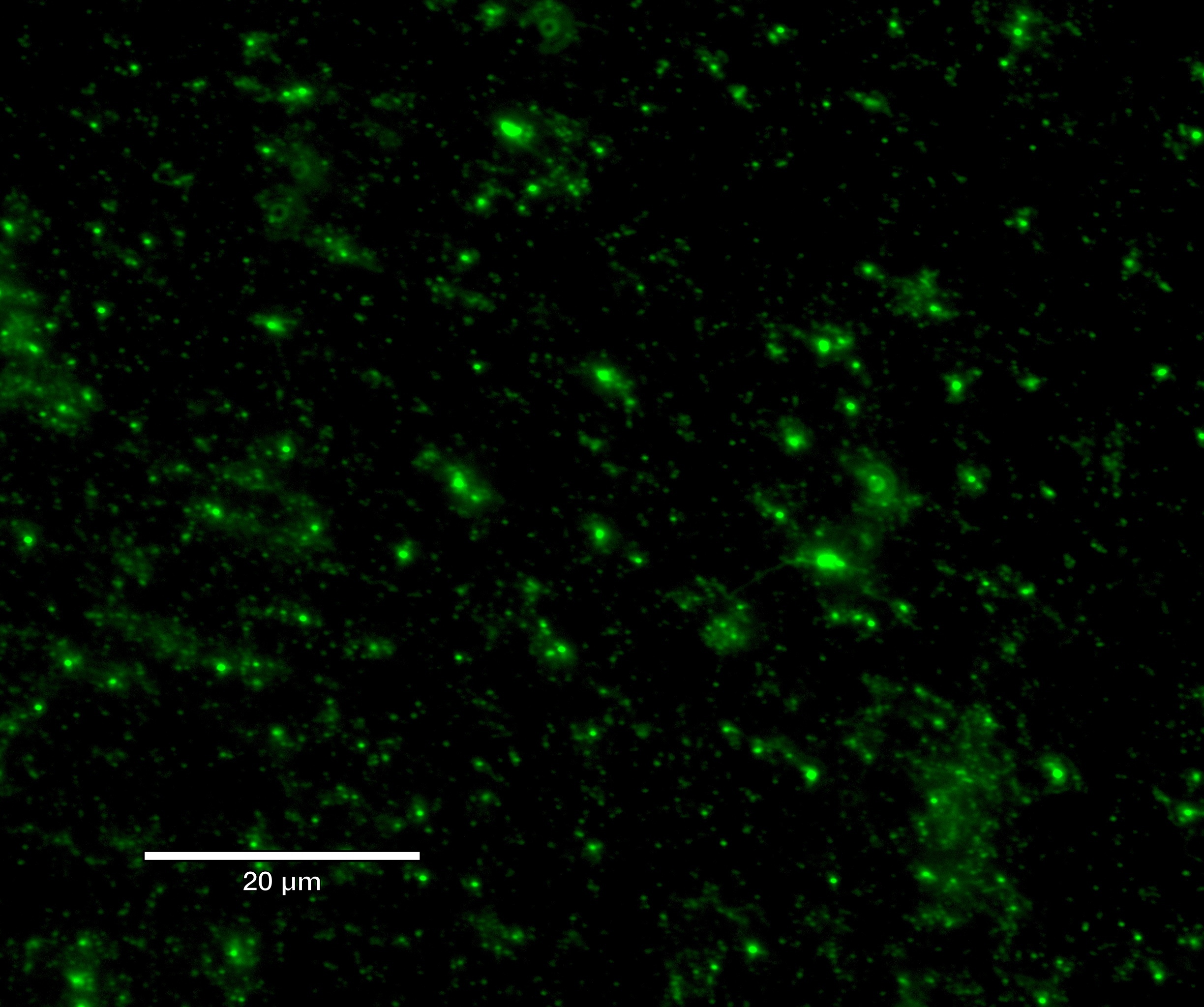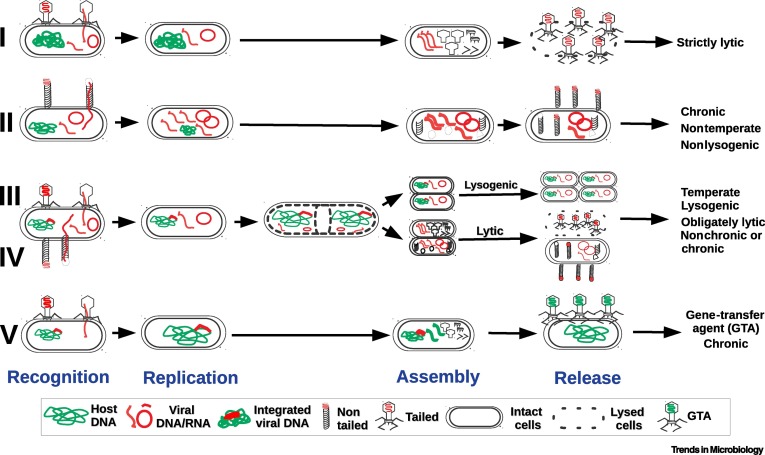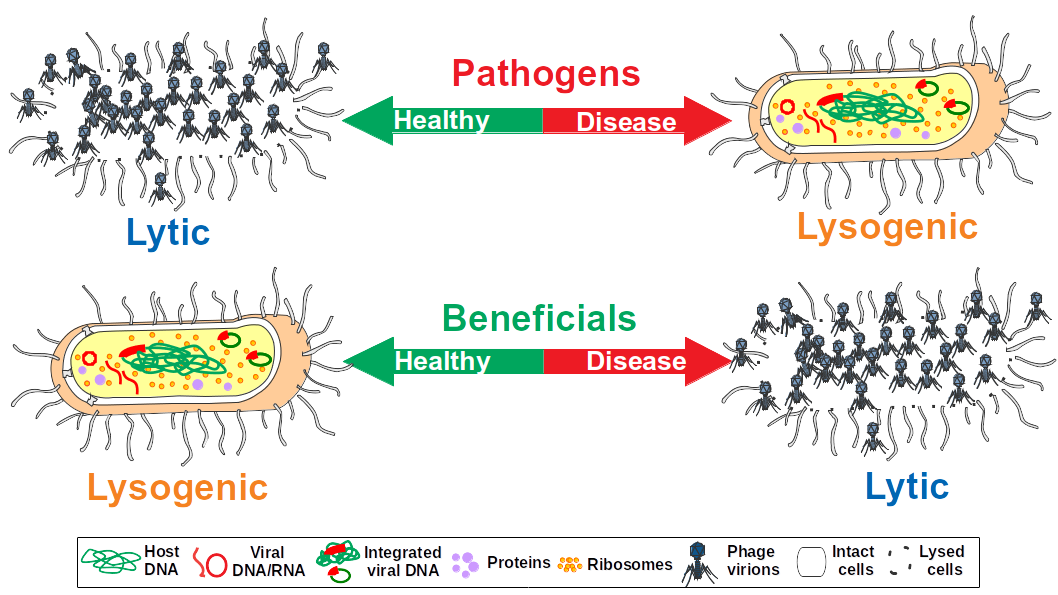WHAT WE DO

The RAW Laboratory is a computational and synthetic biology group that studies - 'Virosphere,' the totality of all viruses on planet Earth that infect all domains of life. Viruses represent the most numerical ‘biological identity,’ on the planet with a global abundance of 1031, which is more than the stars in the observable universe (1021 stars).
We unravel .. Viral lifestyle via the ‘double edge sword,’ hypothesis
Viruses (in particular, bacteriophages) have unique infection lifestyles. In phages, these are classically termed the ‘lytic cycle’ (in which phage DNA is replicated via infectious virion particles) and the ‘lysogenic cycle’ (in which phage DNA replication occurs within a bacterium but without the generation of infectious virion particles). Viral and phage lifestyles are classified in four unique stages ranging from I to V
Stage I. This represents a strictly lytic virus that can replicate its viral nucleic acid or ‘prophage/provirus’ genome as a circular genome (single-stranded or double-stranded), integrated into the host chromosome, or as a linear DNA/RNA genome (single-stranded or double-stranded) for tailed or nontailed viruses.
Stage II. This is commonly found amongst nontailed, filamentous or nonfilamentous, viruses in which replication of the viral genome occurs but without host lysis, the virus leaving the host cell via budding off from the cell membrane. Prophage/provirus in stage II cannot be removed by the host, resulting in a chronic infection.
Stage III. The classical tailed ‘temperate’ phage replication lifestyle. It can be an obligately lysogenic cycle, in which the viral genome is replicated within the host without a viral particle/virion stage, or can enter the lytic cycle and can alternate between lytic/lysogenic cycles. Commonly, stage III is a nonchronic infection as the cell is lysed, thus not allowing for further viral replication.
Stage IV. This is common in nontailed, filamentous or nonfilamentous viruses; it is a chronic infection without cell lysis.
Stage V. There is an additional phage lifestyle, known as stage V, the gene-transfer agent (GTA), which is believed to be nonfunctional or remnant phage that packages random parts of the bacterial genome within its viral particles/virion. The GTA transfers random segments of DNA to another host within the same species or very similar members of the genus.
Stage V. There is an additional phage lifestyle, known as stage V, the gene-transfer agent (GTA), which is believed to be nonfunctional or remnant phage that packages random parts of the bacterial genome within its viral particles/virion. The GTA transfers random segments of DNA to another host within the same species or very similar members of the genus.

The Viral Lifestyle Strategies (Stages I–V)
Viral life strategy/stage I is a strictly lytic virus which infects, replicates viral nucleic acids, and then lyses its host. Stage II infection is followed by replication of the viral genome that occurs but there is no host lysis, and the virus leaves via budding off the cell membrane. The temperate phage lifestyle, or stage III, is when a virus infects then chooses either a lysogenic or lytic path and can modulate between both lytic and lysogenic paths. Stage IV is similar to stage III but there is no cell lysis with chronic infection. Lastly, stage V, known as gene-transfer agent (GTA), is a remnant phage that packages random parts of the bacterial host genome.
Depending whether they are 'lytic' or 'lysogenic', phages can impact microbial host metabolism by increasing or adding metabolic traits or, as an agent of selection, being a ‘double-edged sword’. Lysogenic temperate phages can encode virulence factors that enhance pathogenesis; such factors include toxins, effector proteins, and enzymes. In the context of bacterial pathogens, a phage lysogen increases its ability to infect and replicate within the host, thus increasing viral fitness at the same time. Temperate phage can also prohibit the host’s antiviral response as well as prevent clearance, actively removing pathogens by cell lysis which prevents host death. However, less is known about phage enhancing beneficial or commensal bacteria in host relationships, yet enhancing bacterial fitness is a clear evolutionary advantage of viruses within the environment.

This adds context to the stage III temperate phage lifestyle and is dependent on whether the microbial host is a pathogen or is beneficial to an ecosystem. If a bacterial pathogen invades an ecosystem, lytic phages are useful to remove this pathogen; however, if the temperate phage enters the lysogenic cycle the possibility of the phage increasing pathogen virulence increases. The converse is also true for beneficial or keystone microbes within ecosystems in that lysis via lytic phage could be problematic to an ecosystem.
We elucidate … Complex microbiomes
A variety of increasingly complex microbial ecosystems For example, in the early 2000s, Banfield and co-workers were the first to use a combination of sequencing and MS approaches to study microbiomes in acid mine drainage with low microbial diversity. Subsequently, microbiomes of varying diversity and complexity, including leaf-cutter ant colonies, the termite gut, the human gut, sediments, ocean water samples, permafrost soil, and native prairie soil have been investigated using either advanced sequencing or MS technologies, or both. As the technologies continue to improve, we expect information on new and already studied microbial communities to multiply, providing greater insight into microbial community phenotypes, or phenomes. There are still many challenges that need to be addressed in order to gain a deeper understanding of the molecular functions of microbiomes.
We reveal … Viral - host interactions
We are after... Predictive Knowledge and Mechanistic understanding
The RAW lab uses computation, multi-omics, synthetic biology within our model ecosystems to elucidate and reveal the virosphere’s role. We merge molecular, synthetic biology, multiomics and high performance computation with machine and deep learning. Our overarching goal is predictive science.
We use … Multiomics
We do integrated multi-omics which is a modern field of systems biology, and one of many biology-based interdisciplinary explorations of complex interactions within biological systems that uses a holistic rather than a reductionist approach to biological research. Integrated multi-omics, in both individual organisms and multi-organism communities, leverages the datasets and information from multiple -omes; including genomes (all DNA contained), transcriptomes (all mRNA contained), proteomes (all proteins contained), and metabolomes (all the metabolites contained). In multi-omics, data is directly collected and measured with a variety of instruments.